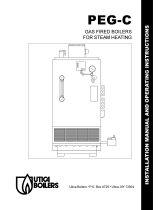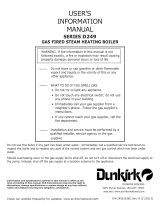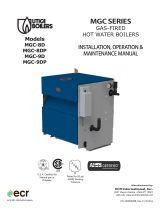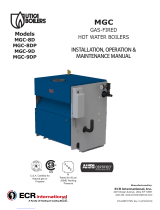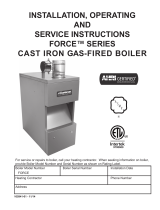
11
When an existing boiler is removed from a common
venting system, the system is likely to be too large for the
proper venting of the appliances sill connected to it. If
this situation occurs, the following test procedure must be
followed:
The vent pipe must slope upward from the boiler not
1.
less then ¼ inch for every 1 foot (21mm/m) to vent
terminal.
Horizontal portions of the venting system shall be
2.
supported rigidly every 5 feet and at the elbows. No
portion of the vent pipe should have any dips or sags.
This boiler series is classied as a Category I. Vent
3.
installation shall be in accordance with "Venting of
Equipment," of the National Fuel Gas Code, ANSI
Z223.1/NFPA 54, or "Venting Systems and Air Supply
for Appliances," of the Natural Gas and Propane
Installation Code, CAN/CSA B149.1, or applicable
provisions of the local building codes.
Inspect chimney to make certain it is constructed
4.
according to NFPA 211. The vent or vent connector
shall be Type B or metal pipe having resistance to heat
and corrosion not less than that of galvanized sheet
steel or aluminum not less than 0.016 inch thick (No.
28 Ga).
Connect ue pipe from draft hood to chimney. Bolt or
5.
screw joints together to avoid sags. Flue pipe should
not extend beyond inside wall of chimney. Do not
install manual damper in ue pipe or reduce size of
ue outlet except as provided by the latest revision of
ANSI Z223.13 or CAN/CSA B149.1. Protect combustible
ceiling and walls near ue pipe with reproof insulation.
Where two or more appliances vent into a common
ue, the area of the common ue must be at least
equal to the area of the largest ue plus 50 percent of
the area of each additional ue.
Vent InstallatIon
!
WARNING
All installations of boilers and venting should
be done only by a qualied expert and in
accordance with the appropriate manual.
Installing or venting a boiler or any other gas
appliance with improper methods or materials
may result in serious injury or death due to
re or to asphyxiation from poisonous gases
such as carbon monoxide with is odorless and
invisible.
!
WARNING
This boiler shall not be connected to any
portion of a mechanical draft system operating
under positive pressure.
Vent systeM ModIfIcatIon
REMOVAL OF BOILER FROM VENTING SYSTEM
At the time of removal of an existing boiler, the following
steps shall be followed with each appliance remaining
connected to the common venting system placed in
operation, while the other appliances remaining connected
to the common venting system are not in operation.
Seal an unused opening in the common venting
1.
system.
Visually inspect the venting system for proper size and
2.
horizontal pitch and determine there is no blockage or
restriction, leakage, corrosion and other deciencies
which could cause an unsafe condition.
Insofar as is practical, close all building doors and
3.
windows and all doors between the space in which the
appliances remaining connected to the common venting
system are located and other spaces of the building.
Turn on clothes dryers and any other appliance not
connected to the common venting system. Turn on
any exhaust fans, such as range hoods and bathroom
exhausts, so they operate at maximum speed. Do
not operate a summer exhaust fan. Close replace
dampers.
Place in operation the appliance being inspected. Follow
4.
the lighting instructions. Adjust thermostat so appliance
will operate continuously.
Test for spillage at the draft hood relief opening after
5.
5 minutes of main burner operation. Use the ame of
a match or candle, or smoke from a cigarette, cigar or
pipe.
After it has been determined that each appliance
6.
remaining connected to a common venting system
properly vents when tested as outlined above, return
doors, windows, exhaust fans, replace dampers and
any other gas burning appliances to their previous
condition of use.
Any improper operation of the common venting system
7.
should be corrected so the installation conforms with
the National Fuel gas Code, ANSI Z223.1/NFPA 54,
and/or the Natural Gas and Propane Installation Code,
CAN/CSA B149.1. When re-sizing any portion of the
common venting system, the common venting system
should be re-sized to approach the minimum size
determined using the appropriate tables in Chapter 13
of the National Fuel Gas Code, ANSI Z223.1/NFPA 54,
and/or the Natural Gas and Propane Installation Code,
CAN/CSA B149.1.




















